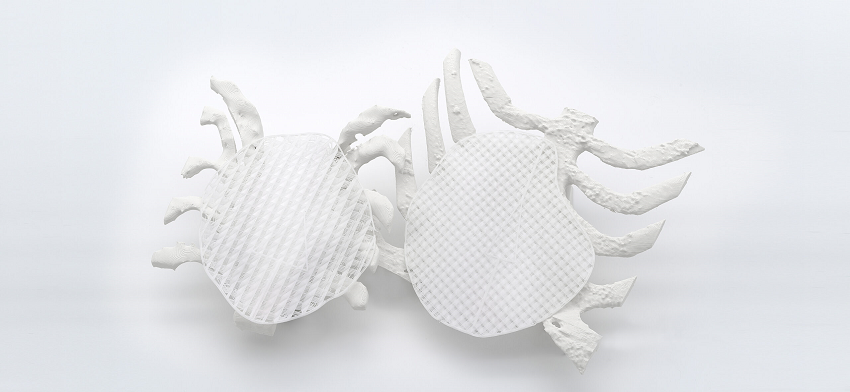Founded in 2015, German medtech company BellaSeno GmbH develops novel resorbable 3D printed soft tissue and bone reconstruction implants, and last summer announced two clinical trials for its 3D printed breast and chest implant products in Australia, where its subsidiary is located. Recently, the ISO 13485-certified clinical stage medical device company was granted authorization in Europe, under EU medical device regulations, for its customized 3D printed bone and pectus excavatum scaffolds. This European market access will allow BellaSeno to take a huge step forward in commercializing 3D printed regenerative medicine products.
Pectus excavatum is a common congenital deformity of the chest wall in which the breastbone is sunken into the chest, and the company’s custom scaffolds for this deformity are some of the first 3D printed regenerative medicine products that can actually be used in reconstructive and plastic surgeries. Expert engineers and treating surgeons work together to create a camouflage for these complex defects using these custom scaffolds, which are 3D printed out of a fully resorbable PCL material. The material guides a patient’s natural tissue to grow into the scaffold, replacing it over time without leaving behind any foreign materials inside the body.
“The initial results from the first patients demonstrate that our resorbable implants are safe, well tolerated and increase the potential of autologous tissue grafts. We are convinced that our approach bears the potential for a paradigm change in regenerative surgery, a field that is in need of innovation to restore complex three-dimensional structures,” stated Dr. med. Tobias Grossner, the Chief Medical Officer of BellaSeno.
The company’s AI-driven, no-touch manufacturing process enables the automated production of medical devices and products with personalized characteristics and high patient safety and scalability, and its proprietary AM technology platform meets the necessary requirements of medical scaffolds for both soft tissue and bone. BellaSeno uses this platform to fabricate several kinds of off-the-shelf and custom sterile medical implants, as well as scaffolds.
“Enabled by BellaSeno’s custom design software, the 3D unit-cell based architectures optimize strength and flexibility. Fully open porous design enables full integration of the implant into the body (i.e. no encapsulation) and vascularization at the regeneration site,” the website states.
Its 3D printed PCL scaffolds for difficult large bone defects are also resorbable and customizable, with “dynamic mechanical compressability.” The scaffolds are bone graft holding cages, which help to “securely retain” both autologous and allogenic bone grafts within a bone’s segmental defects and voids. This is an improvement over the typical autograft tactic for bone regeneration, which lacks stability and can’t be packed into voids in a controlled way.
BellaSeno isn’t all talk, either—it’s already demonstrated, most recently at the European Federation of National Associations of Orthopaedics and Traumatology (EFORT) Congress, that its 3D printed medical scaffolds have excellent mechanical properties, able to withstand longer stress cycles and higher loads than competitors. Plus, earlier this year, the company received market authorization for 3D printed resorbable bone scaffolds made with Evonik’s Resomer polymers.
“We are excited about gaining European market access for our custom-made bone and pectus excavatum scaffolds. Clinical data from patients who have received the scaffolds have been very encouraging to date,” said Mohit Chhaya, CEO of BellaSeno. “We are now seeking market authorizations in other geographic regions and for additional products, such as our off-the-shelf breast implants that are suitable for both breast reconstruction and plastic surgery. Our goal is to become a diversified portfolio company and our versatile and sophisticated manufacturing infrastructure puts us in an excellent position to achieve this goal.”
Subscribe to Our Email Newsletter
Stay up-to-date on all the latest news from the 3D printing industry and receive information and offers from third party vendors.
Print Services
Upload your 3D Models and get them printed quickly and efficiently.
You May Also Like
Reinventing Reindustrialization: Why NAVWAR Project Manager Spencer Koroly Invented a Made-in-America 3D Printer
It has become virtually impossible to regularly follow additive manufacturing (AM) industry news and not stumble across the term “defense industrial base” (DIB), a concept encompassing all the many diverse...
Inside The Barnes Global Advisors’ Vision for a Stronger AM Ecosystem
As additive manufacturing (AM) continues to revolutionize the industrial landscape, Pittsburgh-based consultancy The Barnes Global Advisors (TBGA) is helping shape what that future looks like. As the largest independent AM...
Ruggedized: How USMC Innovation Officer Matt Pine Navigates 3D Printing in the Military
Disclaimer: Matt Pine’s views are not the views of the Department of Defense nor the U.S. Marine Corps Throughout this decade thus far, the military’s adoption of additive manufacturing (AM)...
U.S. Congress Calls Out 3D Printing in Proposal for Commercial Reserve Manufacturing Network
Last week, the U.S. House of Representatives’ Appropriations Committee moved the FY 2026 defense bill forward to the House floor. Included in the legislation is a $131 million proposal for...



































